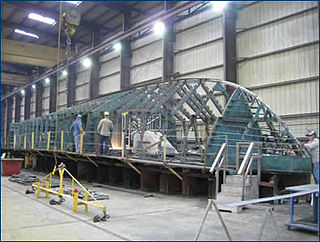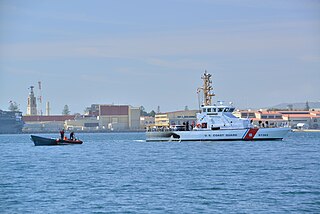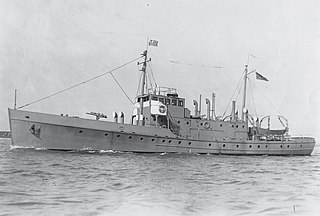
Naval Submarine Base Kings Bay is a base of the United States Navy located adjacent to the city of St. Marys in Camden County, Georgia, on the East River in southeastern Georgia, and 38 miles (61 km) from Jacksonville, Florida. The Submarine Base is the U.S. Atlantic Fleet's home port for U.S. Navy Fleet ballistic missile nuclear submarines capable of being armed with Trident missile nuclear weapons. This submarine base covers about 16,000 acres of land, of which 4,000 acres are protected wetlands.

The Marine Protector class is a class of coastal patrol boats of the United States Coast Guard. The 87-foot-long vessels are based on the Stan 2600 design by Damen Group, and were built by Bollinger Shipyards of Lockport, Louisiana. Each boat is named after sea creatures which fly or swim.

The Island-class patrol boat is a class of cutters of the United States Coast Guard. 49 cutters of the class were built, of which 7 remain in commission. Their hull numbers are WPB-1301 through WPB-1349.
The Medium Endurance Cutter or WMEC is a type of United States Coast Guard Cutter mainly consisting of the 270-foot (82 m) Famous- and 210-foot (64 m) Reliance-class cutters. These larger cutters are under control of Area Commands. These cutters have adequate accommodations for crew to live on board and can do 6 to 8 week patrols.

The M242 Bushmaster chain gun is a 25 mm (25×137mm) single-barrel chain-driven autocannon. It is used extensively by the U.S. military, such as in the Bradley fighting vehicle, as well as by other NATO members and some other nations in ground combat vehicles and various watercraft. Hughes Helicopters in Culver City, California, was the original designer and manufacturer. As of 2019, Northrop Grumman Innovation Systems produces the gun.

The USCGC Morgenthau (WHEC-722), was the eighth of twelve 378-foot dual-powered turbine/diesel Hamilton-class high endurance cutters (WHECs) built by Avondale Shipyards in New Orleans, Louisiana. The Coast Guard commissioned the Morgenthau on March 10, 1969. After 48 years of continuous service the U.S. Coast Guard decommissioned the Morgenthau on April 18, 2017, and the ship was sold to Vietnam. On 27 May 2017 the Vietnam Coast Guard commissioned the former cutter as patrol ship CSB 8020.

The Hamilton-class cutter was the largest class of vessel in the United States Coast Guard until replaced by the Legend-class cutter, aside from the Polar-class icebreaker. The hull classification symbol is prefixed WHEC. The cutters are called the Hamilton class after their lead ship, or the "Secretary class" because most of the vessels in the class were named for former Secretaries of the Treasury, with the exception of the "Hero-class cutters" Jarvis, Munro and Midgett.

The Point-class cutter was a class of 82-foot patrol vessels designed to replace the United States Coast Guard's aging 83-foot wooden hull patrol boat being used at the time. The design utilized a mild steel hull and an aluminum superstructure. The Coast Guard Yard discontinued building the 95-foot Cape-class cutter to have the capacity to produce the 82-foot Point-class patrol boat in 1960. They served as patrol vessels used in law enforcement and search and rescue along the coasts of the United States and the Caribbean. They also served in Vietnam during the Vietnam War. They were replaced by the 87-foot Marine Protector-class coastal patrol boats beginning in the late 1990s.
Bollinger Shipyards is an American constructor of ships, workboats and patrol vessels. Its thirteen shipyards and forty drydocks are located in Louisiana and Texas. Its drydocks range in capacity from vessels of 100 tons displacement to 22,000 tons displacement. The firm was founded in 1946.

The Damen Stan 2600 is a line of patrol vessels built or designed by Netherlands shipbuilding firm the Damen Group.

Some modern patrol vessels are equipped with a stern launching ramp, for deploying smaller rescue or pursuit boats without requiring the parent ship to first come to a halt. Typically the smaller craft are powered by water-jets, and can drive themselves up the ramp by their own power.

USCGC Heriberto Hernandez is the 14th Sentinel-class cutter delivered to the United States Coast Guard. Like five of her sister ships, her initial assignment will see her based in San Juan, Puerto Rico.

USCGC Sea Fox was the last Marine Protector-class coastal patrol boat to be built. Her home port is Bangor, Washington.

USCGC Sea Otter (WPB-87362) is the 61st cutter in the United States Coast Guard's successful Marine Protector class.

USCGC Forrest Rednour (WPC-1129) is the 29th Sentinel-class cutter built for the United States Coast Guard. She was the first of the four vessels of her class to be home-ported at USCG Base Los Angeles/Long Beach in San Pedro, California. Other sister ships have been based in Florida, Mississippi, Puerto Rico, New Jersey, North Carolina, Hawaii, and Alaska prior to Forrest Rednour's assignment to Base LA/LB. Sister ships Robert Ward (WPC-1130), Terrell Horne III (WPC-1131), and Benjamin Bottoms (WPC-1132) soon joined her at Base LA/LB.

USCGC Sea Dragon (WPB-87367) is a Marine Protector-class cutter, that is assigned to one of two special Maritime Force Protection Units. Each unit is assigned to escort nuclear submarines from one the United States Navy's two main submarine bases. Sea Dragon was assigned to Naval Submarine Base Kings Bay.

The USCGC Cochito (WPB-87329) is an 87-foot (27 m) Marine Protector cutter operated by the United States Coast Guard.

USCGC Glen Harris (WPC-1144) is the United States Coast Guard's 44th Sentinel-class cutter.

USCGC Jackson was an Active-class cutter of the United States Coast Guard. She capsized in 1944, killing twenty one of forty crew members.

USCGC Terrapin (WPB-87366) is a United States Coast Guard ship of the Marine Protector class. She is assigned to Coast Guard District 13 and is home-ported at Bellingham, Washington. Her main areas of responsibility are the San Juan Islands, the Strait of Juan de Fuca, and Puget Sound. Her missions include search and rescue, law enforcement, and homeland security.



















